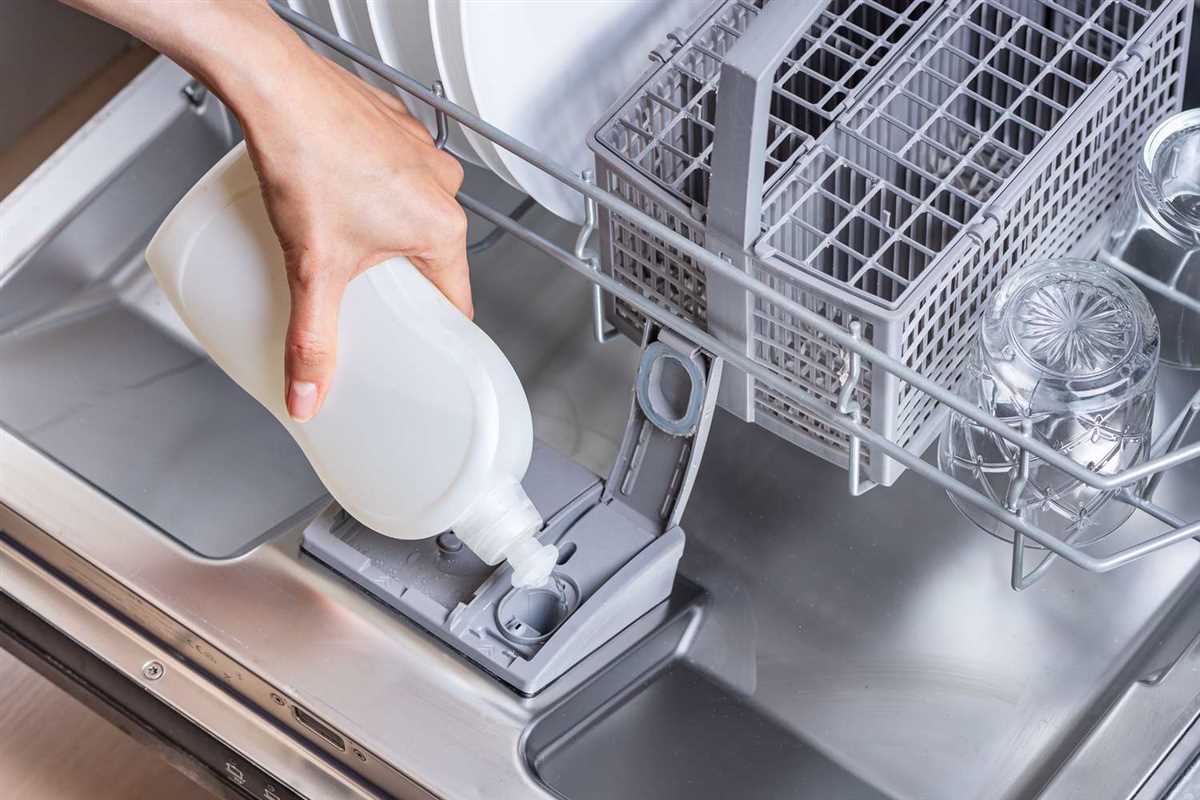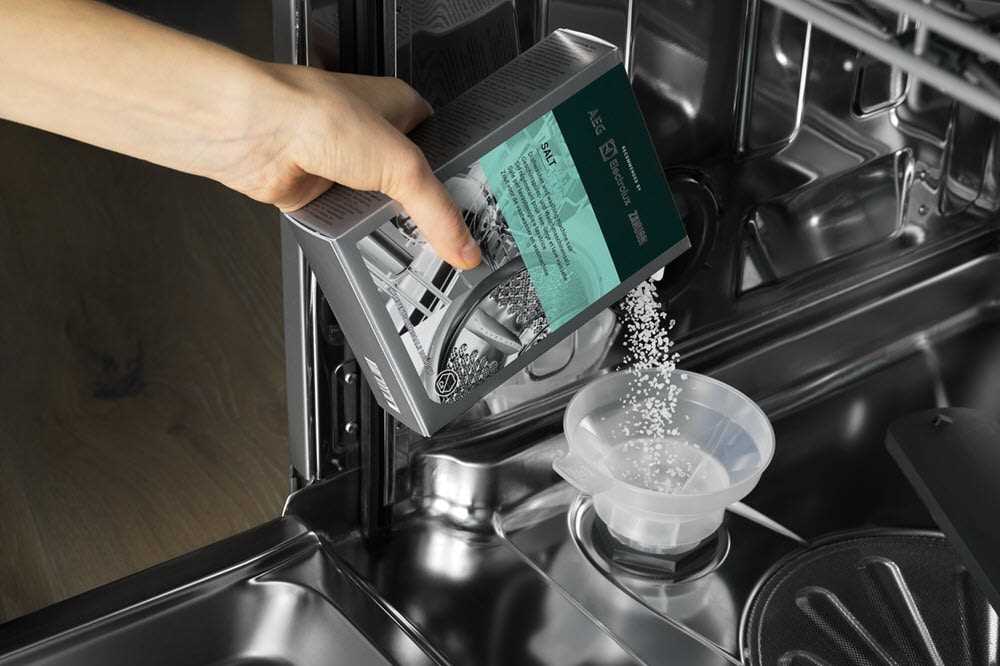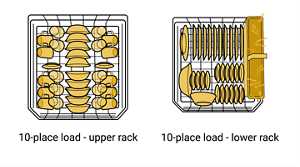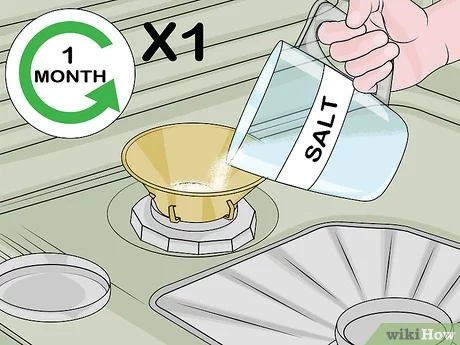




Welcome to our ultimate guide on how to use dishwasher salt! If you’re tired of finding water stains and streaks on your dishes and glasses after each wash, then this guide is for you. We’ll cover everything you need to know about dishwasher salt, from why you need it to how to use it effectively.
1. What is dishwasher salt and why is it important?
Dishwasher salt is a special type of salt that is used in dishwashers to soften the water. Hard water contains minerals like calcium and magnesium, which can stick to your dishes and glasses and create unsightly stains. By using dishwasher salt, you can prevent these minerals from building up and keep your dishes sparkling clean.
2. How does dishwasher salt work?
When you add dishwasher salt to your dishwasher, it goes into a separate reservoir located at the bottom of the machine. The salt then dissolves in water and creates a high concentration of sodium and chloride ions. These ions replace the calcium and magnesium ions in the water, effectively softening it. The water is then used to clean your dishes, leaving them spotless and streak-free.
3. How often should I refill the salt reservoir?
The frequency of salt refill depends on the hardness of your water and how frequently you use your dishwasher. As a general rule, you should check the salt level every 5 to 8 weeks. If the salt level is low, it’s time to refill. You can easily determine the salt level by looking at the indicator on the cap of the salt reservoir or by consulting your dishwasher’s user manual.
4. How to refill the salt reservoir?
To refill the salt reservoir, follow these steps:
- Locate the salt reservoir, usually at the bottom of the dishwasher. It can usually be found by removing the lower rack.
- Unscrew the cap of the salt reservoir. If the cap is stuck, you can use a spanner to loosen it.
- Using a funnel, carefully pour the dishwasher salt into the reservoir. Be sure to follow the arrows on the cap to indicate the direction of the salt flow.
- Screw the cap back on firmly. Make sure it is tightly sealed to prevent any water leaks.
- Replace the lower rack back into the dishwasher and you’re good to go!
5. Which dishwasher salt should I use?
There are many brands of dishwasher salt available on the market. When choosing a dishwasher salt, it’s important to look for one that is specifically designed for dishwashing machines. These salts usually come in the form of tablets or granules. Always check the instructions on the packaging to ensure you are using the right amount of salt for your dishwasher. Remember, using the wrong type or too much salt can damage your dishwasher.
Now that you know how to use dishwasher salt, you can say goodbye to water stains and hello to sparkling clean dishes! Remember to check the salt levels regularly and refill when needed. Happy dishwashing!
What is Dishwasher Salt and Why is it Important?
Dishwasher salt is a specially formulated type of salt that is used in dishwashers to assist with the cleaning process. It plays a crucial role in maintaining the efficiency of your dishwasher and ensuring that your dishes come out sparkling clean every time.
But what exactly does dishwasher salt do? And why is it important to use it?
How Does Dishwasher Salt Work?
Dishwasher salt is primarily used to soften hard water. Hard water contains minerals such as calcium and magnesium ions, which can decrease the effectiveness of dishwashing detergent and leave behind spots and residue on your dishes. This is particularly noticeable in areas with high water hardness levels.
When you add dishwasher salt to the water softening system of your dishwasher, it helps to regenerate the resin used to remove these minerals from the water. The resin attracts the calcium and magnesium ions, allowing the softened water to flow freely through the dishwasher and effectively clean your dishes.
Why is Dishwasher Salt Important?
Using dishwasher salt is important for the following reasons:
- Improved Cleaning Performance: Dishwasher salt helps to maintain the optimal performance of your dishwasher by preventing limescale buildup on the heating element, spray arms, and other dishwasher components. This, in turn, ensures that your dishes are cleaned more effectively.
- Spot-Free Dishes: By softening the water, dishwasher salt prevents the formation of limescale deposits on your dishes, glassware, and cutlery. This helps to keep them looking shiny and spot-free.
- Extended Lifespan of Your Dishwasher: Using dishwasher salt can help to prolong the life of your dishwasher. By preventing limescale buildup, it reduces the strain on the internal components and keeps them functioning properly for longer.
How to Use Dishwasher Salt
Using dishwasher salt is a simple process. Here’s how you can do it:
- Locate the salt reservoir in your dishwasher. It is usually located at the bottom of the dishwasher, often near the filter.
- Unscrew or remove the cap of the salt reservoir.
- If you are adding salt for the first time, make sure it has funnels to pour the salt into the reservoir easily. If not, pour the dishwasher salt carefully to avoid spilling.
- Pour the dishwasher salt into the reservoir. Make sure to fill it firmly, but avoid overfilling.
- Screw the cap or put the cover back on the reservoir, making sure it is securely tightened.
- Run a quick rinse cycle to remove any salt residue that might have spilled during the filling process.
It’s important to note that dishwasher salt and table salt are not the same. Dishwasher salt is specifically designed to work with dishwashers and contains larger granules that dissolve slowly.
Now that you know the importance of using dishwasher salt and how to use it, you can keep your dishwasher clean and running smoothly for years to come!
Understanding Dishwasher Salt and its Role in Dishwashing
Dishwasher salt plays a crucial role in the dishwashing process. It helps to soften the water and prevents mineral buildup in your dishwasher, ensuring that your dishes come out clean and spotless every time. In this article, we will answer some common questions about dishwasher salt and provide tips on how to use it effectively.
What is Dishwasher Salt and What Does it Do?
Dishwasher salt, also known as regeneration salt, is a special type of salt that is used to regenerate the water softener in your dishwasher. Water softening is essential because hard water contains minerals such as calcium and magnesium that can leave deposits on your dishes and inside the dishwasher.
Why Do You Need to Use Dishwasher Salt?

Using dishwasher salt is necessary if you live in an area with hard water. Hard water can affect the performance of your dishwasher and leave residue on your dishes, glassware, and silverware. By using dishwasher salt, you can eliminate hard water problems and ensure that your dishes are always clean and shiny.
How Often Should You Use Dishwasher Salt?

How often you need to use dishwasher salt depends on the hardness of your water and the frequency of use of your dishwasher. As a general rule, if you notice lime scale or residue on your dishes, it’s time to refill the dishwasher salt. It is recommended to check and refill the dishwasher salt every 4-8 weeks.
How to Refill Dishwasher Salt
To refill the dishwasher salt, follow these steps:
- Make sure your dishwasher is empty and turned off.
- Locate the dishwasher’s salt compartment. It is usually at the bottom of the dishwasher.
- Unscrew the cap or remove the cover of the salt compartment. This may require using a spanner or other tool.
- Pour the dishwasher salt into the compartment. Use a funnel if necessary to avoid spilling it everywhere.
- Fill the compartment until it is full. Do not overfill.
- Make sure to screw the cap or replace the cover firmly.
- Run a rinse cycle to dissolve the salt and prevent any leftover salt from getting onto your dishes.
- You’re ready to start using your dishwasher again!
What Type of Dishwasher Salt Should You Choose?
When choosing dishwasher salt, look for a product specifically labeled for use in dishwashers. These salts are usually made from pure sodium chloride or a combination of sodium chloride and other additives to enhance water softening.
How Much Dishwasher Salt Should You Use?

The amount of dishwasher salt you need to use will vary depending on the capacity of your dishwasher and the hardness of your water. It is important to consult your dishwasher’s manual for specific instructions. As a general guideline, the salt compartment should be filled until it is completely full but not overflowing.
Can You Use Table Salt or Other Types of Salt in Dishwashers?
No, you should not use table salt or other types of salt in dishwashers. These salts may contain impurities or additives that can damage your dishwasher and affect its performance. Always use dishwasher salt specifically designed for use in dishwashers.
What to Do if Dishwasher Salt is Spilled in the Dishwasher?
If dishwasher salt is accidentally spilled in the dishwasher, it is important to clean it up immediately. Use a sponge or cloth to remove any spilled salt and rinse the affected area with water. Avoid letting any salt residue dry on the dishwasher’s components, as it can cause damage.
By understanding the importance of dishwasher salt and following the proper guidelines for its use, you can ensure that your dishwasher performs optimally and your dishes come out clean and sparkling every time.
Choosing the Right Dishwasher Salt
When it comes to using dishwasher salt, you may have questions about which one is the right choice. It’s important to choose the right dishwasher salt to ensure that your dishwasher functions properly and your dishes come out clean.
Frequently Asked Questions
- 1. What happens if I use regular table salt instead of dishwasher salt?
- 2. Can I use dishwasher salt if my water is not hard?
- 3. How often should I replace the dishwasher salt?
- 4. Should I always wipe off any spilled dishwasher salt?
- 5. Where should I pour the dishwasher salt?
- 6. What type of salt should I use?
If you use regular table salt in your dishwasher, it can cause damage to the dishwasher’s internal components and lead to poor cleaning results. Therefore, you shouldn’t use regular table salt as a substitute for dishwasher salt.
Even if your water is not hard, it’s recommended to use dishwasher salt. Dishwasher salt helps to soften the water and prevents the build-up of limescale on your dishes and dishwasher.
You should refill your dishwasher salt when it has run out. The frequency of replacement will depend on how often you use your dishwasher and the hardness of your water.
It’s a good practice to wipe off any spilled dishwasher salt. This prevents the salt from coming into direct contact with your dishes and ensures optimal dishwasher performance.
You should pour the dishwasher salt into the salt reservoir of your dishwasher. The salt reservoir is usually located at the bottom of the dishwasher.
You should use dishwasher salt specifically designed for use in dishwashers. Using any other type of salt, such as table salt or sea salt, may not have the same regenerating effect on your dishwasher’s water softener.
How to Choose the Right Dishwasher Salt
- First, unscrew the cap of your dishwasher’s salt reservoir. If the cap is stuck, use a spanner or a similar tool to help you open it.
- Completely remove any remaining salt in the reservoir and rinse it with water.
- Put the dishwasher salt into the reservoir, making sure to fill it up fully.
- Screw the cap back on in a clockwise direction to secure it.
- Wipe off any spilled salt from the bottom of the dishwasher to keep it clean.
Conclusion
Choosing the right dishwasher salt is crucial for the proper functioning of your dishwasher and to ensure clean dishes every time. By following the recommended guidelines and using the correct dishwasher salt, you can extend the lifespan of your dishwasher and avoid potential issues related to hard water. Remember to always refer to the manufacturer’s instructions for your specific dishwasher model.
Factors to Consider when Selecting Dishwasher Salt

When it comes to choosing the right dishwasher salt for your needs, there are several factors to take into consideration. Below are some important factors that can help you make an informed decision:
- Water Hardness: One of the most crucial factors to consider is the hardness of your water. This information can usually be found in your dishwasher’s user manual or by contacting your water provider. Different levels of water hardness require different amounts of dishwasher salt to effectively soften the water.
- Salt Capacity: Check the capacity of your dishwasher’s salt container. You will need to replace the salt periodically, so it’s essential to choose a salt size that fits your dishwasher. Most dishwasher salt containers are located in the bottom of the dishwasher, so make sure you can easily access it.
- Regeneration System: Determine whether your dishwasher has a built-in regeneration system or not. Some dishwashers have a separate compartment where the salt is poured, while others have an automated system that uses salt cartridges. Knowing what type of regeneration system your dishwasher has can help you select the appropriate salt form.
- Resin Funnel Compatibility: If your dishwasher uses a resin funnel for salt dispensing, check if it is compatible with the type of salt you are planning to use. Not all funnels are suitable for all types of salt, so it’s essential to ensure compatibility.
- Water Softening Questions: If you have any questions about water softening or dishwasher salt, consult your dishwasher’s user manual or contact the manufacturer’s customer support. They can provide you with specific information related to your dishwasher model.
- Frequently Asked Questions (FAQs):
- Q: How often should I add dishwasher salt?
- A: It depends on your dishwasher’s salt capacity and water hardness. Generally, you should refill the salt container when it is about 3/4 empty.
- Q: How much dishwasher salt should I put in?
- A: Follow the instructions provided by your dishwasher manufacturer. Typically, you need to pour the salt until it reaches the “FULL” level indicator.
- Q: Can I use table salt or other types of salt instead?
- A: No, you should only use dishwasher salt. Table salt and other types of salt may contain additives that can damage your dishwasher and affect its performance.
- Q: Do I need to completely rinse out the salt container before adding new salt?
- A: No, you don’t need to rinse it out. Simply pour the new salt directly into the container without removing any residual salt.
- Q: What else can I use dishwasher salt for?
- A: Dishwasher salt is specifically designed for water softening in dishwashers. It is not suitable for any other purposes.
- Conclusion:
Choosing the right dishwasher salt is essential for the proper functioning of your dishwasher. Consider factors such as water hardness, salt capacity, regeneration system, and resin funnel compatibility. Follow the instructions provided by your dishwasher manufacturer, and if you have any questions, consult your dishwasher’s user manual or contact the manufacturer’s customer support.
How to Add Dishwasher Salt to Your Dishwasher
Adding dishwasher salt to your dishwasher is an important step to ensure optimal performance and longevity of your appliance. The dishwasher salt helps to regenerate the resin in your dishwasher’s water softener, preventing the buildup of minerals that can affect the cleaning efficiency and leave residue on your dishes.
Step 1: Prepare to Add Salt

- Make sure your dishwasher is empty and there are no dishes or utensils inside it.
- Consult your dishwasher’s manual to locate the salt reservoir. It is usually located at the bottom of the dishwasher, in or near the filter.
- Unscrew the cap or lid of the salt reservoir, and you may need to wipe away any residual salt or water.
Step 2: Add the Salt
- Using a funnel can make it easier to pour the salt into the reservoir. This will help avoid any spills or messes.
- Pour the dishwasher salt into the reservoir until it is completely full. Be sure to use the right type of salt specifically designed for dishwashers.
- After adding the salt, wipe away any salt residue or spills on the dishwasher.
- Screw the cap or lid back onto the salt reservoir until it is tightly secured.
Step 3: Run the Dishwasher
- Now that you’ve added the dishwasher salt, you can run your dishwasher as usual.
- Choose the appropriate dishwasher cycle and settings based on your needs.
- The dishwasher will automatically dispense the salt during the wash cycle to soften the water by releasing magnesium and other ions.
- Make sure to refill the salt reservoir when it’s empty or running low. Check the salt level frequently to ensure it doesn’t run out completely.
By adding dishwasher salt to your dishwasher, you’re helping to keep your dishes clean and free from mineral residue. The salt aids in the regeneration process, ensuring that your dishes come out sparkling every time. Follow these simple steps, and you’ll have a well-functioning dishwasher that does its job efficiently.
Step-by-Step Guide on Adding Dishwasher Salt
Adding dishwasher salt is a crucial step in maintaining the optimal performance of your dishwasher. Follow these simple steps to add dishwasher salt:
Step 1: Check if your dishwasher has a salt reservoir
Not all dishwashers have a built-in salt reservoir. Check your dishwasher’s manual or look for a compartment with a screw cap on the bottom of your dishwasher.
Step 2: Unscrew the cap of the salt reservoir
Once you have located the salt reservoir, unscrew the cap anti-clockwise to open it. Some dishwashers may have arrows indicating the direction to turn.
Step 3: Add the dishwasher salt
- Grab the dishwasher salt bag or box.
- Ensure that your dishwasher is not running or in use.
- Pour the dishwasher salt into the reservoir using a funnel to avoid spillage. Use the recommended amount of salt stated in your dishwasher’s manual or as advised by the salt packaging.
- Make sure to fully fill the reservoir, but be careful not to overfill.
Step 4: Screw the cap back on
Once the reservoir is filled with dishwasher salt, screw the cap back on firmly in a clockwise direction. Ensure it is securely tightened to prevent any leakage.
Step 5: Run a rinse cycle
To ensure the dishwasher salt is properly distributed and dissolved, run a rinse cycle after adding the salt. This will help the salt to mix with the water and achieve the desired water hardness level.
Now you know how to add dishwasher salt to your dishwasher. Follow these steps whenever you need to refill the salt reservoir to keep your dishwasher running efficiently.
Common Mistakes to Avoid When Using Dishwasher Salt

- Adding Dishwasher Salt in the Wrong Place: Make sure you add dishwasher salt to the designated salt compartment of your dishwasher. This compartment is usually located at the bottom of the dishwasher, near the filter. Refer to your dishwasher’s manual to locate it.
- Pouring Dishwasher Salt Directly into the Dishwasher: Instead of pouring the salt directly into the dishwasher, you should always use the salt dispenser provided. This dispenser is designed to evenly distribute the salt throughout the dishwasher, ensuring proper water softening.
- Not Unscrewing the Salt Dispenser Cap: Before adding salt, unscrew the salt dispenser cap by turning it anti-clockwise. This will allow you to fill the dispenser with salt.
- Overfilling or Underfilling the Salt Dispenser: Follow the manufacturer’s instructions on the amount of salt to add. Generally, filling the dispenser up to the marked level, indicated by arrows, is sufficient. Adding too much or too little salt can negatively affect the water softening process.
- Adding Dishwasher Salt when the Dispenser Needs Refilling: It’s important to add dishwasher salt only when the dispenser needs to be refilled. Check the salt level regularly, and if it’s still filled, there is no need to add more salt. Adding salt unnecessarily can lead to wastage and buildup in the dishwasher.
- Not Screwing the Salt Dispenser Cap Firmly After Refilling: After filling the salt dispenser, make sure to screw the cap back on firmly. This will prevent any salt from leaking out during the dishwasher cycle.
- Using Dishwasher Salt Instead of Dishwashing Tablets: Dishwasher salt is used for water softening, while dishwashing tablets are used for cleaning. They serve different purposes, so it’s important to use them correctly. Read the instructions on the packaging of your dishwasher detergent to ensure proper usage.
- Rinsing or Wiping the Salt Dispenser: When refilling the salt dispenser, there is no need to rinse or wipe it. The salt will dissolve once the dishwasher is activated. Any excess salt should be wiped away carefully to avoid clogging or damaging the dispenser.
By avoiding these common mistakes, you can ensure optimal performance and longevity of your dishwasher while using dishwasher salt. Always follow your dishwasher’s manual and the manufacturer’s instructions for best results.
FAQ
What is dishwasher salt and why is it used?
Dishwasher salt is a special type of salt that is used in dishwashers to help soften hard water. It also helps to prevent limescale buildup and improve the performance of the dishwasher.
How does dishwasher salt work?
Dishwasher salt works by regenerating the ion exchange resin in the water softener of the dishwasher. It replaces the calcium and magnesium ions in the water with sodium ions, which helps to prevent limescale buildup and improve the efficiency of the dishwasher.
How often should I add dishwasher salt?
The frequency of adding dishwasher salt depends on the hardness of your water and the usage of the dishwasher. As a general guideline, you should check the salt level every month and add more if necessary.
Can I use table salt instead of dishwasher salt?
No, you should not use table salt instead of dishwasher salt. Table salt may contain additives that can damage the dishwasher. Dishwasher salt is specifically designed for use in dishwashers and is free of additives.
How do I add dishwasher salt to my dishwasher?
To add dishwasher salt, you first need to locate the salt compartment in your dishwasher. It is usually located at the bottom of the dishwasher near the filter. Open the compartment and pour the salt into it, making sure not to overfill it. Then, close the compartment and run a pre-wash cycle to rinse away any excess salt.
What do I do if I run out of dishwasher salt?
If you run out of dishwasher salt, you can still use your dishwasher, but it may not perform as effectively. It is best to refill the salt compartment as soon as possible to maintain the performance of your dishwasher.
What are the signs that my dishwasher salt needs to be refilled?
Some signs that your dishwasher salt needs to be refilled include limescale buildup on your dishes or in the dishwasher, cloudy glassware, and a decrease in the performance of your dishwasher. Checking the salt level regularly can help you avoid these issues.











